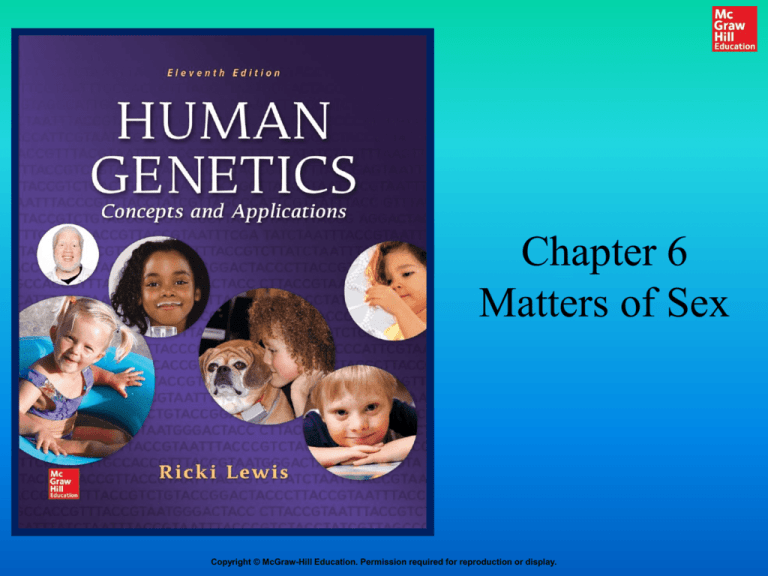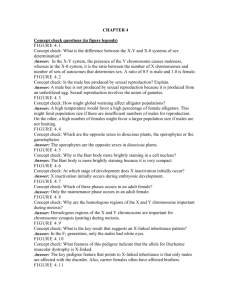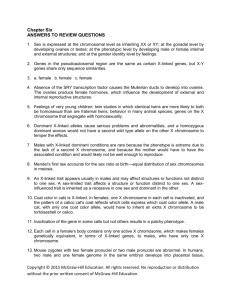Human Genetics
advertisement

Chapter 6 Matters of Sex Copyright © McGraw-Hill Education. Permission required for reproduction or display. Learning Outcomes • Describe the factors that contribute to whether we are and feel male or female • Distinguish between the X and Y chromosomes • Discuss how manipulating sex ratio can affect societies • Distinguish between Y linkage and X linkage Copyright © McGraw-Hill Education. Permission required for reproduction or display. 2 Learning Outcomes • Compare and contrast X-linked recessive inheritance and X-linked dominant inheritance • Discuss the inheritance pattern of a trait that appears in only one sex • Define sex-influenced trait • Explain why X inactivation is necessary • Explain how X inactivation is an epigenetic change Copyright © McGraw-Hill Education. Permission required for reproduction or display. 3 Learning Outcomes • Discuss how X inactivation affects the phenotype in female mammals • Explain the chemical basis of silencing the genetic contribution from one parent • Explain how differences in the timetables of sperm and oocyte formation can lead to parentof-origin effects Copyright © McGraw-Hill Education. Permission required for reproduction or display. 4 Our Sexual Selves • Maleness or femaleness is determined at conception • Another level of sexual identity comes from the control that hormones exert on development of reproductive structures • Biological factors and social cues influence sexual feelings Copyright © McGraw-Hill Education. Permission required for reproduction or display. 5 Sexual Development • During the fifth week of prenatal development, all embryos develop two sets of: • Unspecialized (indifferent) gonads • Reproductive ducts - Müllerian (female-specific) and Wolffian (male-specific) • An embryo develops as a male or female based on the sex chromosome constitution and actions of certain genes • Specifically the SRY gene (sex-determining region of the Y chromosome) Copyright © McGraw-Hill Education. Permission required for reproduction or display. 6 Sex Chromosomes Determine Gender • Human males are the heterogametic sex with different sex chromosomes, (XY) • Human females are the homogametic sex (XX) • In other species sex can be determined in many ways • For example, in birds and snakes, males are homogametic (ZZ), while females are heterogametic (ZW) Copyright © McGraw-Hill Education. Permission required for reproduction or display. 7 Figure 6.2 Copyright © McGraw-Hill Education. Permission required for reproduction or display. 8 X and Y Chromosomes • X chromosome • Contains > 1,500 genes • Larger than the Y chromosome • Acts as a homolog to Y in males • Y chromosome • Contains 231 genes • Many DNA segments are palindromes and may destabilize DNA replication Copyright © McGraw-Hill Education. Permission required for reproduction or display. 9 X and Y Chromosomes Figure 6.1 Copyright © McGraw-Hill Education. Permission required for reproduction or display. 10 Anatomy of the Y Chromosome • Pseudoautosomal regions (PAR1 and PAR2) • 5% of the chromosome • Contains genes shared with X chromosome • Male specific region (MSY) • 95% of the chromosome • Contains majority of genes including SRY and AZF (needed for sperm production) Figure 6.3 Copyright © McGraw-Hill Education. Permission required for reproduction or display. 11 SRY Gene • Encodes a transcription factor protein • Controls the expression of other genes • Stimulates male development • Sends signals to the indifferent gonads to destroy female structures • Stimulates development of male structures • Testosterone and dihydrotesterone (DHT) are secreted, stimulate male structures Copyright © McGraw-Hill Education. Permission required for reproduction or display. 12 Abnormalities in Sexual Development • Androgen insensitivity syndrome = Lack of androgen receptors • Pseudohermaphroditism = Presence of male and female structures at different stages of life • 5-alpha reductase deficiency = Absence of DHT • Congenital adrenal hyperplasia = High levels of androgens Copyright © McGraw-Hill Education. Permission required for reproduction or display. 13 Figure 6.4 Copyright © McGraw-Hill Education. Permission required for reproduction or display. 14 Homosexuality • Person’s phenotype and genotype are consistent • Physical attraction is toward members of the same sex • Homosexuality has been seen in all cultures for thousands of years • Documented in 500 animal species Copyright © McGraw-Hill Education. Permission required for reproduction or display. 15 Homosexuality • Evidence suggests a complex input from both genes and the environment • Identical twins are more likely to be homosexual than members of fraternal twin pairs • Genetic markers were identified on the X chromosome more often identical among pairs of homosexual brothers Copyright © McGraw-Hill Education. Permission required for reproduction or display. 16 Egg with x chromosome Fertilized by Fertilized by Sperm with X chromosome Sperm with Y chromosome Embryo with XY Chromosomes Sex-determining region of the Y chromosome (SRY) brings about development of undifferentiated gonads into testes Chromosomal sex Gonadal sex Embryo with XX Chromosomes No Y chromosome, so no SRY. With no masculinizing influence, undifferentiated gonads develop into ovaries Testes secrete masculinizing hormones, including testosterone, a potent androgen In presence of testicular hormones, undifferentiated reproductive tract and external genitalia develop along male lines No androgens secreted Phenotypic sex With no masculinizing hormones, undifferentiated reproductive tract and external genitalia develop along female lines Copyright © McGraw-Hill Education. Permission required for reproduction or display. 17 Copyright © McGraw-Hill Education. Permission required for reproduction or display. 18 Sex Ratios • The proportion of males to females in a human population • Calculated by # of males / # of females multiplied by 1,000 • Primary sex ratio – At conception • Secondary sex ratio – At birth • Tertiary sex ratio – At maturity • Sex ratios can change markedly with age • Reflects medical conditions and environment factors Copyright © McGraw-Hill Education. Permission required for reproduction or display. 19 Y-linked Traits • Genes on the Y chromosome are said to be Ylinked • Y-linked traits are very rare • Transmitted from male to male • A female does not have a Y chromosome • Currently, identified Y-linked traits involve infertility and are not transmitted Copyright © McGraw-Hill Education. Permission required for reproduction or display. 20 X-linked Traits • Patterns of expression on the X chromosome differ in females and males • Females - X-linked traits are passed like autosomal traits • Males - A single copy of an X-linked allele causes expression of the trait or illness • Human male is considered hemizygous for Xlinked traits Copyright © McGraw-Hill Education. Permission required for reproduction or display. 21 Sex Determination in Humans Figure 6.5 Copyright © McGraw-Hill Education. Permission required for reproduction or display. 22 X-linked Recessive Inheritance Copyright © McGraw-Hill Education. Permission required for reproduction or display. 23 X-linked Recessive Traits • Examples: • Ichthyosis = enzyme deficiency blocks removal of cholesterol from skin cells • Color-blindness • Hemophilia = Disorder of blood-clotting Copyright © McGraw-Hill Education. Permission required for reproduction or display. 24 Figure 6.6 Copyright © McGraw-Hill Education. Permission required for reproduction or display. 25 Figure 6.7 Copyright © McGraw-Hill Education. Permission required for reproduction or display. 26 X-linked Dominant Inheritance Copyright © McGraw-Hill Education. Permission required for reproduction or display. 27 X-linked Dominant Traits Incontinentia pigmenti Figure 6.8 Copyright © McGraw-Hill Education. Permission required for reproduction or display. 28 X-linked Dominant Traits Congenital generalized hypertrichosis Figure 6.9 Copyright © McGraw-Hill Education. Permission required for reproduction or display. 29 Solving Genetic Problems • Steps to follow: • Look at the inheritance pattern • Draw a pedigree • List genotypes and phenotypes and their probabilities • Assign genotypes and phenotypes to parents • Determine how alleles separate into gametes • Unite the gametes in a Punnett square Copyright © McGraw-Hill Education. Permission required for reproduction or display. 30 Solving Genetic Problems • Determine the phenotypic and genotypic ratios for the F1 generation • To predict further generations, use the genotypes of the F1 and repeat steps 4 to 6 Copyright © McGraw-Hill Education. Permission required for reproduction or display. 31 Sex-Limited Traits • Traits that affect a structure or function occurring only in one sex • The gene may be autosomal or X-linked • Examples: • Beard growth • Milk production • Preeclampsia in pregnancy Copyright © McGraw-Hill Education. Permission required for reproduction or display. 32 Sex-Influenced Traits • Allele is dominant in one sex but recessive in the other • Difference in expression can be caused by hormonal differences between sexes • Example: • Pattern baldness in humans • A heterozygous male is bald, but a heterozygous female is not Copyright © McGraw-Hill Education. Permission required for reproduction or display. 33 X Inactivation • Females have two alleles for X chromosome genes but males have only one • In mammals, X inactivation balances this inequality in the expression of genes on the X chromosome • A female mammal is a mosaic for expression of most genes on the X chromosome • XIST gene encodes an RNA that binds to and inactivates the X chromosome Copyright © McGraw-Hill Education. Permission required for reproduction or display. 34 X Inactivation • X inactivation occurs early in prenatal development • The adult female has patches of tissue that differ in their expression of X-linked genes • Alters the phenotype and not the genotype • It is an example of an epigenetic change • An inherited change that does not alter the DNA base sequence Copyright © McGraw-Hill Education. Permission required for reproduction or display. 35 Figure 6.10 Copyright © McGraw-Hill Education. Permission required for reproduction or display. 36 X Inactivation • Used to check the sex of an individual • Nucleus of a cell of a female, during interphase, contains a Barr body • Consequence of X inactivation on the phenotype • Homozygous X-linked genotypes - No effect • Heterozygotes - Leads to expression of one allele or the other Copyright © McGraw-Hill Education. Permission required for reproduction or display. 37 X Inactivation • A female that expresses the phenotype corresponding to an X-linked gene is a manifesting heterozygote • X inactivation is obvious in calico cats Figure 6.11 Copyright © McGraw-Hill Education. Permission required for reproduction or display. 38 X Inactivation Animation Please note that due to differing operating systems, some animations will not appear until the presentation is viewed in Presentation Mode (Slide Show view). You may see blank slides in the “Normal” or “Slide Sorter” views. All animations will appear after viewing in Presentation Mode and playing each animation. Most animations will require the latest version of the Flash Player, which is available at http://get.adobe.com/flashplayer. Figure 2.3 Copyright © McGraw-Hill Education. Permission required for reproduction or display. X Inactivation • In humans, X inactivation can be used to identify carriers of some X-linked disorders • Lesch-Nyhan syndrome • Affects the severity of Rett syndrome • Unequal X inactivation pattern can occur if the two X chromosomes have different alleles for a gene that controls cell division • Gives certain cells a survival advantage Copyright © McGraw-Hill Education. Permission required for reproduction or display. 40 Parent-of-Origin Effects • Parental origin influences phenotype • Age of onset • Symptom severity • Mechanisms of parent-of-origin effects • Genomic imprinting • Differences between developmental timetables of sperm and oocytes Copyright © McGraw-Hill Education. Permission required for reproduction or display. 41 Genomic Imprinting • Methyl (CH3) groups bind a gene or several linked genes • Prevent them from being accessed to synthesize protein • Parental effect on gene expression is seen as diseases inherited from a parent • Epigenetic alteration - Layer of meaning stamped upon a gene without changing its DNA sequence Copyright © McGraw-Hill Education. Permission required for reproduction or display. 42 Methyl Groups Figure 6.12 Copyright © McGraw-Hill Education. Permission required for reproduction or display. 43 • Imprints are erased during meiosis • Then reinstituted according to the sex of the individual Figure 6.13 Copyright © McGraw-Hill Education. Permission required for reproduction or display. 44 Importance of Genomic Imprinting • Function of imprinting isn’t well understood, may be a way to regulate abundance of key proteins in the embryo • Imprinted genes are in clusters along a chromosome, controlled by imprinting centers • One gene in a cluster could be essential for early development • Others become imprinted due to bystander effect Copyright © McGraw-Hill Education. Permission required for reproduction or display. 45 Importance of Genomic Imprinting • Research suggests that it takes two opposite sex parents to produce a healthy embryo • Male genome controls placenta development • Female genome controls embryo development • Genomic imprinting may also explain incomplete penetrance • May be a concern in assisted reproductive technologies Copyright © McGraw-Hill Education. Permission required for reproduction or display. 46 Teratoma Figure 6.14 Copyright © McGraw-Hill Education. Permission required for reproduction or display. 47 Imprinting and Human Disease • Two distinct syndromes result from a small deletion in chromosome 15 • Prader-Willi syndrome • Deletion inherited from father • Angelman syndrome • Deletion inherited from mother Copyright © McGraw-Hill Education. Permission required for reproduction or display. 48 Imprinting and Human Disease • Abnormal imprinting is associated with: • • • • Diabetes mellitus Autism Alzheimer disease, schizophrenia Male homosexuality Copyright © McGraw-Hill Education. Permission required for reproduction or display. 49 Imprinting and Human Disease Deletion on chromosome 15 reveals imprinting Figure 6.15 Copyright © McGraw-Hill Education. Permission required for reproduction or display. 50 Different Timetables in Sperm and Oocyte Formation • Differences in development of sperm and oocytes explain some parent-of-origin effects • Huntington disease • Noonan syndrome Copyright © McGraw-Hill Education. Permission required for reproduction or display. 51






